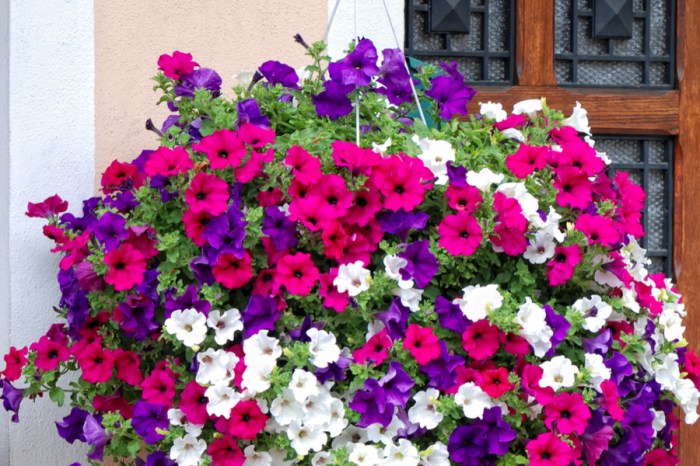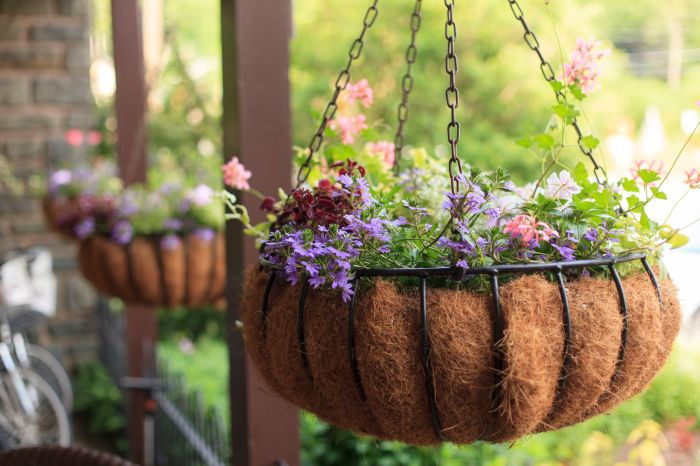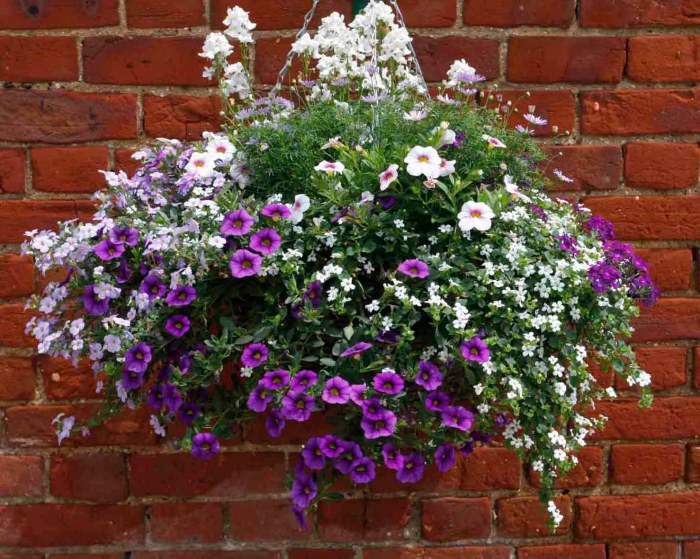Hanging basket plant care is an art form that combines horticultural knowledge with a keen eye for aesthetics. Whether you’re a seasoned gardener or a novice enthusiast, this guide will provide you with the essential information you need to create and maintain thriving hanging baskets that will add a touch of elegance and vibrancy to your outdoor space.
From selecting the right plants and preparing the perfect soil to watering, fertilizing, and troubleshooting common issues, this comprehensive guide covers every aspect of hanging basket plant care. Get ready to embark on a journey that will transform your hanging baskets into flourishing oases of color and beauty.
Choosing the Right Plants

Selecting the right plants for your hanging baskets is crucial for their health and visual appeal. Consider the following factors:
- Sunlight requirements:Choose plants that thrive in the amount of sunlight your hanging basket will receive.
- Water needs:Select plants with similar watering requirements to avoid over- or under-watering.
- Growth habits:Consider the size and shape of the plants to ensure they fit well in the basket and create a visually appealing arrangement.
Companion Planting, Hanging basket plant care
Companion planting involves growing different plant species together to create mutually beneficial relationships. In hanging baskets, consider pairing plants with:
- Nutrient-fixers:Legumes, such as peas and beans, can fix nitrogen from the air, benefiting neighboring plants.
- Pollinators:Flowers that attract pollinators, such as petunias and marigolds, can benefit fruit-bearing plants.
- Repellents:Plants like marigolds and basil release scents that deter pests, protecting other plants in the basket.
Container and Soil Preparation

Selecting the right hanging basket is crucial for the health and appearance of your plants. Opt for baskets that are large enough to accommodate the root systems of your chosen plants, allowing for proper growth and development. Consider the material of the basket as well; porous materials like wicker or coco liners promote airflow and drainage, while plastic or metal baskets retain moisture more effectively.
Soil Preparation
Prepare a well-draining potting mix by combining potting soil, compost, and perlite or vermiculite in equal parts. This blend provides essential nutrients, improves soil structure, and ensures proper drainage to prevent waterlogging. To further enhance nutrient availability, incorporate a slow-release fertilizer into the soil mixture.
Hanging basket plant care involves selecting the right plants, providing adequate sunlight and water, and fertilizing regularly. For a unique and eye-catching addition, consider the hanging basket turtle vine plant . This vine cascades beautifully, producing heart-shaped leaves and delicate flowers.
Like other hanging basket plants, the turtle vine requires regular watering, bright indirect light, and occasional feeding with a balanced fertilizer.
This will provide a steady supply of nutrients over an extended period, promoting healthy plant growth and minimizing the need for frequent fertilization.
Watering and Fertilizing

Establishing a consistent watering and fertilizing regimen is crucial for the well-being of plants in hanging baskets. Watering frequency should be adjusted based on the specific plant’s needs and the prevailing environmental conditions.
Hanging basket plant care involves selecting the right plants, providing adequate sunlight and water, and fertilizing regularly. For a unique and eye-catching addition, consider the hanging basket turtle vine plant . This vine cascades beautifully, producing heart-shaped leaves and delicate flowers.
Like other hanging basket plants, the turtle vine requires regular watering, bright indirect light, and occasional feeding with a balanced fertilizer.
Checking Soil Moisture
To determine the appropriate watering schedule, it’s essential to regularly check the soil moisture. Insert a finger into the soil to a depth of about two inches. If the soil feels dry to the touch, it’s time to water.
Adjusting Watering Frequency
The frequency of watering will vary depending on factors such as the plant’s water requirements, the size of the hanging basket, and the temperature and humidity of the environment. During hot, dry weather, plants may need to be watered more frequently, while during cooler, humid periods, watering can be reduced.
Fertilizing Hanging Baskets
Fertilizing hanging baskets is equally important to ensure optimal plant growth and health. A balanced, water-soluble fertilizer should be applied according to the manufacturer’s instructions.
Avoiding Overwatering and Overfertilizing
It’s crucial to avoid overwatering and overfertilizing, as both can harm plants. Overwatering can lead to root rot, while overfertilizing can burn the plant’s roots and cause nutrient imbalances.
Hanging basket plants can add a touch of greenery and color to any space. With the right care, they can thrive and bring joy for years to come. For those in Ireland, there are many resources available to help with hanging basket plant care.
One such resource is hanging basket plants ireland , which provides comprehensive information on the best plants for hanging baskets in Ireland, as well as tips on care and maintenance. By following these guidelines, you can ensure that your hanging basket plants will flourish and provide beauty and enjoyment for seasons to come.
Pruning and Maintenance: Hanging Basket Plant Care

Maintaining the health and appearance of hanging basket plants involves regular pruning and upkeep. Pruning encourages healthy growth, prevents overcrowding, and improves the plant’s overall shape and vigor.
Pruning Techniques
Pruning methods vary depending on the plant type. Deadheading, or removing spent blooms, is essential for promoting continuous flowering and preventing seed production. Shaping techniques, such as pinching back or cutting stems, help control growth and maintain a desired shape.
Hanging basket plant care involves selecting the right plants, providing adequate sunlight and water, and fertilizing regularly. For a unique and eye-catching addition, consider the hanging basket turtle vine plant . This vine cascades beautifully, producing heart-shaped leaves and delicate flowers.
Like other hanging basket plants, the turtle vine requires regular watering, bright indirect light, and occasional feeding with a balanced fertilizer.
Other Maintenance Tasks
In addition to pruning, other maintenance tasks are crucial for hanging basket plant health. Regularly removing spent blooms helps prevent disease and encourages new growth. Cleaning the basket periodically removes debris and ensures proper drainage. Inspecting plants for pests and diseases allows for early detection and treatment, preventing the spread of problems.
Troubleshooting Common Issues
Hanging basket plants bring a touch of beauty to any space, but they can also encounter problems that affect their health and appearance. Identifying and addressing these issues promptly is crucial to maintain thriving plants.
Wilting Leaves
Wilting leaves can indicate several problems, including underwatering, overwatering, or root rot. Check the soil moisture by inserting a finger. If the soil is dry, water thoroughly. If the soil is soggy, reduce watering frequency and improve drainage by adding perlite or pumice to the potting mix.
Root rot, caused by excessive moisture, can be treated by repotting the plant into fresh soil and pruning away any damaged roots.
Yellowing Leaves
Yellowing leaves can be a sign of nutrient deficiency, particularly nitrogen. Fertilize the plant regularly with a balanced fertilizer to replenish nutrients. Alternatively, yellowing leaves can indicate overwatering or poor drainage. Adjust watering practices and ensure the container has adequate drainage holes.
Pests
Common pests that affect hanging basket plants include aphids, mealybugs, and spider mites. Treat infestations promptly with insecticidal soap or neem oil. Preventative measures include regular inspection, isolating infected plants, and maintaining good plant hygiene.
Closing Summary
Hanging basket plant care is a rewarding endeavor that allows you to enjoy the beauty of nature while adding a personal touch to your surroundings. By following the tips and techniques Artikeld in this guide, you can create and maintain stunning hanging baskets that will bring joy and tranquility to your life for seasons to come.
FAQs
What are the most popular plants for hanging baskets?
Some of the most popular plants for hanging baskets include petunias, impatiens, begonias, geraniums, and fuchsias.
How often should I water my hanging baskets?
The frequency of watering will depend on the type of plants in your basket, the weather conditions, and the size of the basket. As a general rule, water your hanging baskets when the top inch of soil feels dry to the touch.
How do I fertilize my hanging baskets?
Fertilize your hanging baskets every two to four weeks with a balanced liquid fertilizer. Be sure to follow the instructions on the fertilizer label.